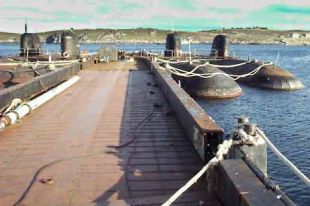
From Ukraine peace plans to Kazakh uranium—all that and more in our new nuclear digest
Our November Nuclear Digest by Bellona’s Environmental Transparency Center is out now. Here’s a quick taste of just three nuclear issues arising in U...
News

Publish date: December 2, 2003
Written by: Charles Digges
News
According to the officials, who asked not to be identified, the CEG took up discussions—that the media were not allowed to attend—at its meeting two weeks ago about how nuclear remediation projects between Russia and other countries should be formed.
According to the officials, there was a consensus that risk impact studies prior to the beginning of nuclear dismantlement work, security issues, transparency in funding, audits and regular inspections of work in progress should form the basis for all nuclear agreements with Russia. This conclusion was reached, said the official because of the lessons learned by the experience of the inspections carried out by Norway.
These officials said that an international workshop on risk assessment on dismantling nuclear installations and submarines in Russia would be held in the United Kingdom early next year.
Norway’s Deputy Minister of Foreign Affairs Kim Traavik repeated this information in Norwegian Parliament on Monday, and repeated the need for international risk assessment for these projects.
The discussion was taken up, one source said, because of recent mishaps that were made public last summer concerning Russias €10m deal to dismantle two retired Victor class submarines. Norwegian representatives at the CEG—pressured by a stern parliament at home—put the question of risk assessment for all countries entering in to nuclear assistance programmes with Russia on the agenda.
We are hopeful that Russia and donor nations will find a basic approach, one official told Bellona Web. Improved environmental risk assessment has to be comprehensive.
He said that the CEG agreed to examine the impact of spent fuel reprocessing in bilateral and multilateral nuclear remediation deals with Russia. Though the source underscored that the CEG was only an information discussion group with no regulatory authority, he said that the information discussed at the meetings flowed upward to decision and policy makers who have the authority to implement plans discussed.
The CEG is a forum for information exchange, but it gives an impulse for cooperation, said the source. Ultimately, that cooperation resides with Russia, but dismantlement programmes have to be decided between donor countries and Russia.
The shadow of the K-159
One of the main problems with the Norwegian-Russian sub dismantlement deal was the fact that the vessels were towed by tugboats to their decommissioning destinations—a problem that might not have crossed anyones radar screen where it not for the sinking of the K-159 submarine in August.
Stationed at Gremikha Naval Base—like the two Victors Norway is dismantling—the K-159 sank with 800 kilograms of spent nuclear fuel and nine sailors after its tow line snapped during transportation to the Polyarny shipyard on the northern Kola Peninsula.
Towing is a common, but extremely dangerous process, and revelations that Norway had financed—or simply had neglected to examine the environmentally hazardous means that would be employed in dismantling the subs—left the Norwegian Foreign Affairs Ministry confronted by an enraged parliament and a media revealing embarrassing revelations on how little research had gone into the project.
Contract money
It also remains unclear as to whether any of the 10m that Norways Foreign Affairs Ministry gave Russia for the dismantlement project is being used to reprocess the submarines fuel. The Norwegian Parliament’s powerful Control and Constitution Committee, however, made a majority recommendation in 2002 that Norway refuse to finance any nuclear assistance projects involving reprocessing.
In the contract original contract brought to the Norwegian province of Finnmark by First Deputy Atomic Minister Sergei Antipov, Minatom stipulated that the Norwegian side would be paying for the reprocessing spent fuel from the two Victor class submarines it would dismantle.
Norwegian Foreign Minister Kim Traavik, who was to sign the June 12 agreement for Norway, was forced to turn the deal down.
Is Norway covering reprocessing anyway?
But less than three weeks later, on June 30, a new contract had been drawn up and signed by both parties. By the accounts of many observers, this was a speedy redrafting of the contract, which was undertaken mostly by Minatom.
The dismantlement money within the revised contract, which was obtained by Bellona Web, was redistributed in such a way as to allocate more funding to transportation of spent nuclear fuel to the Mayak reprocessing facility in the Urals. There was also more free money for Minatom connected to cleanup activities in Andreyeva Bay, the Northern Fleets notoriously contaminated dumping site located 60 kilometers from the Norwegian border.
Concerns that the spent nuclear fuel from the Victor class submarines Norway is dismantling might be the reprocessed on Norwegian money were raised by Bellona and the Norwegian media. This put enormous pressure on the Norwegian Ministry of Foreign affairs after the June 30th signing of the dismantlement contract.
It is unknown if any of this money shuffling could be a cover for reprocessing the fuel. During a question period in parliament, Foreign Ministry officials have been vague that such could be the case.

Our November Nuclear Digest by Bellona’s Environmental Transparency Center is out now. Here’s a quick taste of just three nuclear issues arising in U...

For three years now, Bellona has continued its work in exile from Vilnius, sustaining and expanding its analysis despite war, repression, and the collapse of international cooperation with Russia in the environmental and nuclear fields

The Board of the Bellona Foundation has appointed former Minister of Climate and the Environment Sveinung Rotevatn as Managing Director of Bellona No...

Økokrim, Norway’s authority for investigating and prosecuting economic and environmental crime, has imposed a record fine on Equinor following a comp...